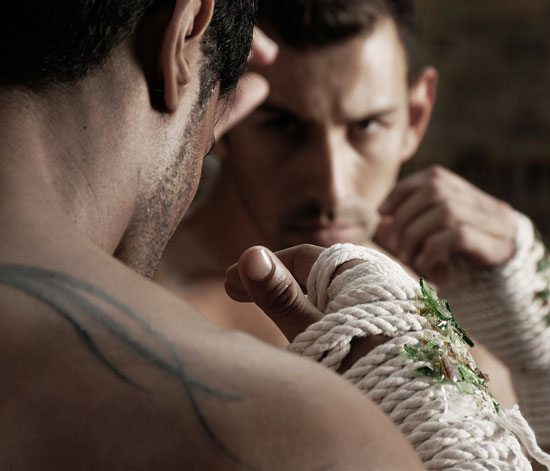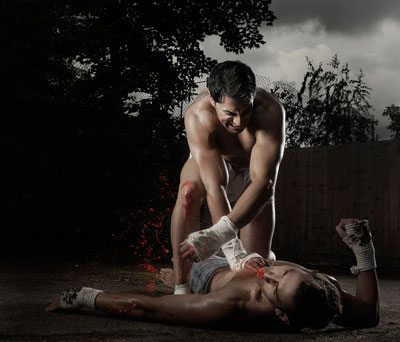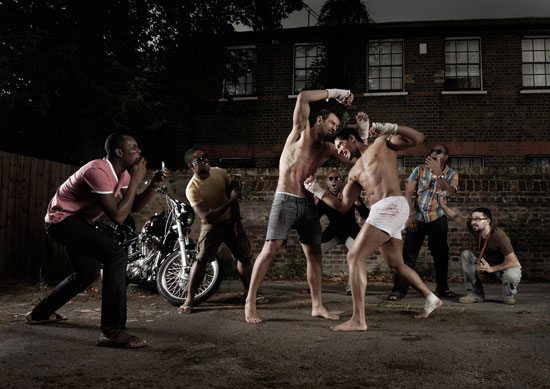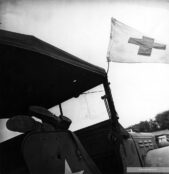David Otokpa is not yet a name known to many outside the London graduate photography scene.
However, with his vivid Fight Club series he has already won over a number of high profile advocates and has successfully created an aura of trajectory to his potential. He’s making a mark.
The Fight Club series presents a series of conflicted scenarios which devoid of the antagonist/protagonist duality force the viewer to consider these visceral scenes in terms of their situated composition rather than emotional import. In many respects dispassionate and moderately reflexive, David Otokpa’s work has a maturity and depth rarely seen in much graduate work.
The care Otokpa takes in setting up each of his frames shows that he is not an artist that sits back and allows people to freely ‘find their own meaning’. He works hard to include a number of factors in each of his shots that knowingly guide the viewer through a number of propositions in sequence. This more than anything is the quality that elevates his work as being worthy of further investigation.
 In person Otokpa is genial and workmanlike discussing his work as a number of straightforward processes rather than adopting the customary evasiveness common to many artists. Prior to attending the American Intercontinental University Otokpa studied engineering in Michigan and worked in commercial photography. It seems both experiences have heighted a natural discipline and sense of efficiency. Speaking to him over strong coffee it is clear that chance and waste are given a short leash both creatively and personally.
In person Otokpa is genial and workmanlike discussing his work as a number of straightforward processes rather than adopting the customary evasiveness common to many artists. Prior to attending the American Intercontinental University Otokpa studied engineering in Michigan and worked in commercial photography. It seems both experiences have heighted a natural discipline and sense of efficiency. Speaking to him over strong coffee it is clear that chance and waste are given a short leash both creatively and personally.
A Nigerian by birth, Otokpa’s biography runs the usual course of relative local privilege, diaspora, education, return and reflection. A history that Otokpa is neither forthcoming nor reticent about, it seems his story is simply that and no more than the setting for his observations, and while clear about the questions he asks in his work, in many cases he proposes self reflection as the answer. An outsider’s position? Perhaps, but in an era of glib justifications and emotional positions over critical ones there is a universality here that infuses his work with a sort of electric relevance; a strong achievement to anyone’s name.
Talking loosely about his commercial work with an Architectural client he discussed the importance of light.
David Otokpa: Light can be used to enhance the shot and bring focus to certain elements.
I use light and shadows to hide and reveal but also I use shadow to play with textures since the way the light works can bring out the texture of whatever it is; fabric, concrete, skin. I think this is a really important consideration when you’re trying to capture depth.
When I look at an image or consider a shot I see several things. I know what I want to be the focus (for the viewer), and how other things can bring the shot together. Because you can have too much in the shot that pulls your eye in too many ways. Naturally I want the brightest part of the shot to be the focus but also to bring in other elements that lead people to see other things afterwards.
Trebuchet: Sounds like you want to create a narrative. As in, after seeing the initial focus of the shot people are drawn to other elements sequentially. So for a shot taken in an instant there is a sense of timing in how people discover things within that shot.
Exactly, I’m influenced by cinema more than a bit. So narrative and storytelling are really important to me. I’m very much influenced by Gregory Crewdson, whose work most closely mirrors my own, or at least whose work I see most of myself in. The story within the image. So even without seeing several images you get a sense of Story, and then in a great context you can see several images (in series) and get something even larger.
Looking around (at photographers like Crewdson) I realised that I could be better and so I started thinking about attending a school that would give me more formal training. I also found that a lot of the photographers I looked up to, the one thing they had in common was an education in fine art.
 I don’t like to use the word perfectionist; because you know… but if I think something can be better, I keep at it. I knew that there was growth that… well you get it.
I don’t like to use the word perfectionist; because you know… but if I think something can be better, I keep at it. I knew that there was growth that… well you get it.
With the American Intercontinental University I noticed that it wasn’t just a photography degree. This was important for me because in composing a photograph elements of graphic design, print, illustration even all come together to inform your working process as a photographer. Without being a jack-of-all-trades but having an idea of how things work (for instance in graphic design there is a strong idea of how things come together) is a big part of being a photographer. How you compose something will make or break the shot. So, after talking to the faculty I realised that this would be a good place of me.
Trebuchet: Do you use a lot of post-processing with your shots?
I try and get it right in the shot itself. In the fight club series a lot of the actual work was done in camera. I’m not totally against post (since I obviously use it) but I am against it (in general), because if you can’t do it on set and try it in post, it either takes too much time to do it or you can’t do it well enough. For instance, HDR shots look great with the moody sky etc. but to the trained eye it becomes obvious what has happened and you think ‘oh okay, this is happening here etc.’ which isn’t… (laughs) well I guess I just like getting it all in the shot. It’s the challenge of it I like. But I’m not against post work. I mean, there are some photographers who say ‘you should never crop, you should only ever crop in camera’ and they’re quite purist about it. I’m not like that at all I’ll do whatever needs to be done; I’ll crop, I’ll dodge and burn, I’ll retouch if I have to… You know, whatever the shot needs.
Trebuchet: What do you think about those types of dogmas in photography?
I think the process of working – on anything – shouldn’t be set in stone. I mean it is photography, it’s not curing AIDS. You should be able to look at things from any angle and say; ‘this will work for this situation’ rather than necessarily coming at it with something prior. But then, once you step away from the work, after the fact, you should be able to say; ‘okay so this needs this here, I’ll retouch this here’.
Trebuchet: Tell me about the Fight Club series.
I went to a boxing match and I found it really interesting that as a society we’ve moved on in that we drive cars etc. but the underlying fact is that we are no different from cavemen. There’s still the primitive and the primal, like the gladiator era, but legal. I could see that this is what it must be like where you are getting pummelled but you can’t back down because of your fans and you know you should but you just won’t.
 I thought it was really interesting how society looks up to primitive idols like supermodels and boxers. It shifted my view of what I wanted to do with the work. Everyone does a fight series and it’s almost the same thing every time; it’s a beautiful lady in the ring, and maybe she’s wearing boxing gloves, and there’s a guy in wraps, you know what I mean?
I thought it was really interesting how society looks up to primitive idols like supermodels and boxers. It shifted my view of what I wanted to do with the work. Everyone does a fight series and it’s almost the same thing every time; it’s a beautiful lady in the ring, and maybe she’s wearing boxing gloves, and there’s a guy in wraps, you know what I mean?
At the time I was working a lot with classical art, the Greeks and the Romans, statues, the ideal bodies. So with the series I wanted to do something that really pushed the envelope and has a subject matter that would make people think ‘oh this really isn’t for me’ and make it aesthetically pleasing, even beautiful. I wanted something that referenced the classical forms of the human body, which is why the shots are very stylised. I’ve brought out the body structure and contours and at the same time making it bloody (which could have put people off). At the same time I wanted people to be able to look at it and be comfortable with it. Because that’s what it is when people go to a fight; you know it’s going to be bloody, you know it’s going to be violent. So I knew that I had to have certain things in place that would make both men and women think okay this is ‘good’.
Trebuchet: Do you think it’s disturbing that people are comfortable with this level of violence?
(long pause) It’s a reference. I want the viewer to decide for themselves. They way I interpret it is based on a lot of things; how I grew up, where I’ve been, what I’ve seen. So people have to have their own narratives on what they like or don’t etc.
Trebuchet: In terms of the narrative who are the guys in the background?
They’re anyone, they’re everybody. It’s a good range of people it’s the crowd. There’s not usually one person that’s solely responsible for any given thing. For instance, there are people that go on strike and individually they just won’t work but that’s not what is happening on a larger level. On any given thing it’s a domino effect of how one person can affect another. So in terms of the narrative it’s about looking at the situation as a whole. There are cases where you can say of someone ‘you are responsible’ but behind that there is a bunch of other things going on.
In this case, they’re not obviously on either fighter’s side they’re just watching and cheering. It’s important for me to have the guy with the video phone there because you could look at this picture and just watch it. I guess it’s a little bit ‘fourth wall’. It’s society today, they’re watching it at the time but millions are also watching.
The set-up itself was very structured, it wasn’t left to chance. I set up where people were to stand and gave them very strict movements so we could capture people in motion but still get the composition. That said, when working with models, costume or make-up artists I leave room for their vision to come through as well, so it’s a mixture.
Trebuchet: Asking a churlish question, how did you get the blood effect?
We tried all sorts of things to get the effect of blood mixed with spit. It had to look right when he was being punched or kicked. In the end he was actually physically kicked to make it look right. They had a good level of control but they weren’t both fighters; one was and the other was a dancer. It was important to me that it wasn’t just fighters. I wanted it so that that element could be anyone but also that there was enough difference that it could be any two people; the guy from the office, a banker, someone you see on the street.
I want anyone who looks at it to see that. The two guys have different body types etc. There’s no ‘this is the winner, this is the loser’. The shot is taken at an indeterminate part of the fight, it could go either way. So hopefully in a sense it’s at that point when people will get into the narrative enough to ask, not only ‘what’s happening?’ but also ‘what’s going to happen next?’. ‘Who are these people?’ it’s open… who do you think they are? Who do you want them to be?
See David Otokpa’s work at the D&AD New Blood Exhibition July 1-4th, Old Truman Brewery, London.
All Images Copyright of David Otokpa 2011.

Editor, founder, fan.






















